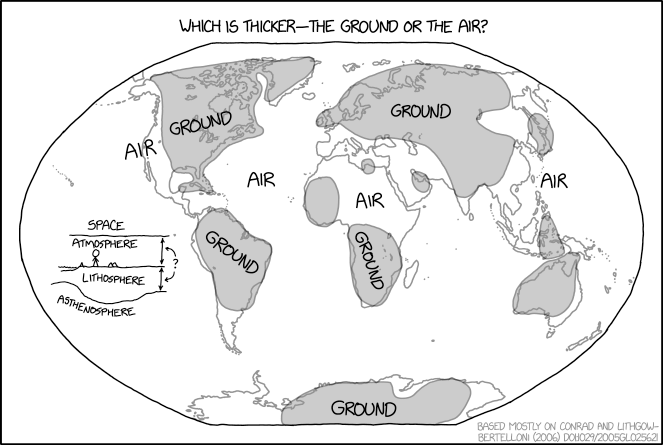2242: Ground vs Air
| Ground vs Air |
 Title text: Water is thinner than both, and fire is *definitely* thicker. |
Explanation
| This is one of 62 incomplete explanations: New page If you can fix this issue, edit the page! |
This is a map, referring to the thickness of ground, vs the thickness of air.
Transcript
| This is one of 36 incomplete transcripts. Please help by editing it! |
Discussion
Wow; it took longer than I care to admit to realize 'thick' wasn't 'viscosity'...but 'altitude'. (i.e., height/thickness re: Kynde's comment) Elvenivle (talk) 01:08, 17 December 2019 (UTC)
A link to the article is here: https://agupubs.onlinelibrary.wiley.com/doi/full/10.1029/2005GL025621. 162.158.186.192 01:12, 17 December 2019 (UTC)
It's probably worth mentioning in the explanation which map projection Randall chose to use for this comic from those listed in a previous comic about map projections. Ianrbibtitlht (talk) 02:22, 17 December 2019 (UTC)
And by these metrics, blood is even thinner than water... 162.158.107.199 (talk) 04:48, 17 December 2019 (UTC) (please sign your comments with ~~~~)
But everything changed when the fire nation attacked 108.162.229.250 10:47, 17 December 2019 (UTC)
I assume ocean ridges have a very thin crust, meaning they get the ratio more towards air? I am not at all a geologist, so I ask this question, because ridges would intiutively appear to have a bigger crust, as they stand out from the ground. "That definition would, of course, have resulted in a significantly different picture where the air is thicker than the ground only inside small areas around mid-ocean ridges" should be explained by someone who knows why it is the case. --Lupo (talk) 14:26, 17 December 2019 (UTC)
- Mid-ocean ridges can even be raised above the ocean surface--Iceland is actually the high point on one of them. In other places they're trenches, though. Since seafloor crust is spreading at those points, it's at its thinnest there on average. Nitpicking (talk) 02:08, 18 December 2019 (UTC)
- Would you feel confident, adding that in a concise way to the explanation? I do not... But I am glad I learned something by that. That might also explain why these ocean ridges tend to be equipped with volcanoes. I thought the reasoning was the other way round: They are ridges due to their geothermal activity. --Lupo (talk) 07:27, 18 December 2019 (UTC)
- I have done this! And added a bit more earth science knowledge besides. And while Iceland is the highest point on the ridge, I'm not sure I'd say it's actually because of the ridge - Iceland is a hot spot the same way Hawaii (which is not on a ridge) is.108.162.219.62 21:29, 30 January 2020 (UTC)
- Would you feel confident, adding that in a concise way to the explanation? I do not... But I am glad I learned something by that. That might also explain why these ocean ridges tend to be equipped with volcanoes. I thought the reasoning was the other way round: They are ridges due to their geothermal activity. --Lupo (talk) 07:27, 18 December 2019 (UTC)
The current explanation seems to include water-thickness in with (either) air or ground thickness in discussing it in the initial transition from air to ground. Depends how you read it, which, but it easily reads as either. Maybe edit that aside out from that bit, then make sure that sliver of water is gone into later (...end of that para? ...footnote mention?) that sometimes the air ends at sea-level and ground starts after the depth of sea? 162.158.34.46 12:28, 18 December 2019 (UTC)
- Just done what I think you asked for, as luck would have it. (And then redid it slightly to avoid adjectival and verb forms of "separate" appearing so close together.) 162.158.154.91 19:46, 18 December 2019 (UTC)
The current explanations refers to fire as being 12000km, I would rather go with the radius of 6000km. Makes more sense to me since we are on a sphere and not counting the crust thickness twice.108.162.216.52 17:52, 18 December 2019 (UTC)
Should we make a Comics with Citations category? Seems like it's warranted 141.101.69.53 19:21, 18 December 2019 (UTC)
XKCD is he only webcomic where mentioning the type of map projection in an explanation would not be needless pedantism. —Kazvorpal (talk) 18:52, 22 January 2020 (UTC)
- "Pedantry" 172.70.85.177 08:52, 14 June 2022 (UTC)
((Following unsigned comment moved away from the top, before making my reply, to where it's more chronological...))
Isn't this just a map of elevation? 172.70.114.71 (talk) 04:16, 14 June 2022 (UTC) (please sign your comments with ~~~~)
- Clearly not, as it covers areas of sea/ocean where elevation is a consistent zero (or possibly negative, according to your convention).
- As illustrated, it's a balance of the amount of 'solid' rock vs the air above, with ground-level elevation (or sea-bed depression?) affecting the air-thickness above more reliably (given the fluidity of air as it gathers and spreads and heats and cools and thus generally evens out) than the span of the rock below which relies upon geological time-scales of shifting that are overwhelmed by the consistency of what the current bit of buoyant rock is (density, strength, etc) and whether tectonics is locally clumping it up or thinning it out beneath a given bit of continent or ocean. 172.70.85.177 08:52, 14 June 2022 (UTC)
 Add comment
Add comment
